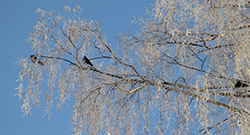Winter began throughout the country in January
 Bild: Eija Vallinheimo
Bild: Eija VallinheimoAccording to the Finnish Meteorological Institute (FMI), January's mean temperature varied from Åland's approx. -6 Celsius to -15 Celsius in northernmost Lapland. Compared to Finland's long term average the mean temperature was lower than usual in the majority of the country for the first time since July 2013. Only the coast of the Bothnian Sea was near the long term average. The greatest deviations were in the southwest of the country and in northernmost Lapland, where it was over two Celsius colder than usual.However, the month's mean temperature does not depict the month's temperatures very well, as the month was very unevenly split temperature-wise. The ten first days of the month were even exceptionally mild for this time of year, whereas towards the month's end it was at times exceptionally cold. On 11 January, thermal winter finally began in the most southern part of Finland.The month's highest temperature of 6.1 Celsius was measured at Långnäs harbour in Åland on 8 January. The month's lowest temperature of -40.7 Celsius was measured at Kevojärvi in Utsjoki on 20 January. The previous time the temperature dropped to below -40 Celsius was almost two years ago in February 2012.
Exceptionally low precipitation levels this January in Central Finland
In January, the country's southernmost parts and part of Southern Lapland received as much as over 30 mm of precipitation, the country's southwest over 50 mm. However, less than 10 mm of precipitation fell in parts of Ostrobothnia and in Central Finland. Compared to the long term average, precipitation levels were markedly lower than usual in the majority of the country; Central Finland and Northern Lapland received less than half of their norm. Central Finland was in general dryer than usual and in some places exceptionally dry. Previously, a January has been this lacking in precipitation in 1972, 1987, 1996 and 2006. Of individual observation stations the most precipitation was measured at Tvärminne in Hanko; a total of 55.3 mm. The least precipitation, a total of just 6.1 mm, was measured at Möksy in Alajärvi. On 7 January, the country's greatest daily rainfall of 16.7 millimetres was measured at Utö in Parainen.
January ended with little snow in South and Central Finland
By the end of January, the entire country had a snow cover, although there was generally less than 10 cm of snow, in southern and central parts of the country; as little as less than 5 cm in many locations. There was exceptionally little snow for this time of year especially in North Karelia, North Savo and southern parts of Northern Ostrobothnia. The thickest snow cover was in Northwest Lapland, and the largest snow depth of 96 cm was measured at Kilpisjärvi in Enontekiö. There was also a great amount of snow in Central Lapland and in Koillismaa, where there was generally over 60 cm of snow.
More information:
January weather statistics: http://ilmatieteenlaitos.fi/tammikuu